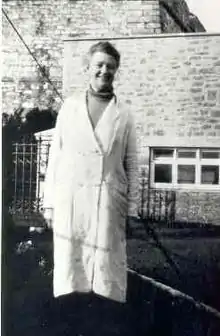Marie Lebour
Marie Victoire Lebour (20 August 1876 – 2 October 1971) was a British marine biologist known for her study of the life cycles of various marine animals. She published more than 175 works during her long career.[1]
Marie Lebour | |
|---|---|
 | |
| Born | 20 August 1876 Woodburn, Northumberland |
| Died | 2 October 1971 (aged 95) |
| Awards | Fellow of the Zoological Society |
| Academic background | |
| Alma mater | Durham University |
| Academic work | |
| Institutions | University of Leeds, Marine Biological Laboratory of Plymouth |
| Main interests | Marine biology |
Early life and education
Marie Lebour was born the youngest of three daughters to Emily and George Lebour in Woodburn, Northumberland on 20 August 1876. Her father was a professor of geology and Marie regularly joined him on expeditions, collecting specimens for her own collections. She attended Armstrong College and studied art, then went on to Durham University, where she earned degrees in zoology: an associate degree in 1903, bachelor's degree in 1904, master's degree in 1907, and doctorate in 1917.[1][2][3]
Career and research
In 1900, before beginning her scientific education, Lebour began her research career with a paper on land and freshwater mollusks in Northumberland. While studying for her master's degree, Lebour was on staff at Durham University. From 1906–1909, she was a demonstrator in the University of Leeds Department of Zoology; from 1909–1915 she was also an assistant lecturer. Lebour's professional research career was entirely conducted at the Marine Biological Association's Laboratory at Plymouth,[4][5]where she joined the research staff in 1915. She was a full staff member there until 1946, then an honorary staff member until she could no longer conduct research due to health problems, in 1964.[1][2][3]
Her main research interest was the larval stages of both trematodes (a type of mollusk parasite) and mollusks themselves. She published more than 100 papers on these topics during her career. She also worked on microplankton, and discovered at least 28 new species,[3] which she cataloged in two books. After publishing these books, Lebour used the newly invented plunger jar to better study the egg and larval stages of krill in the North Atlantic, Antarctica, and Bermuda. She also published well-regarded work on the eggs and larvae of sprat, herring, and pilchards. She also conducted research in West Africa. She retired at the age of 70, in 1946, but continued to work into the laboratory and publish until she was 88 and her failing vision prevented her from working at the microscope.[1][2][3]
She died on 2 October 1971, at the age of 95.[3] Many of Lebour's publications are still used by researchers.[2]
Honors and legacy
Lebour was a member of several professional societies. She was a fellow of the Linnaean Society, a lifetime fellow of the Zoological Society, and a member of the Marine Biological Association of the United Kingdom. She was remembered fondly by her colleagues.[1][2][3]
References
- Ogilvie, Marilyn; Harvey, Joy (2000). The Biographical Dictionary of Women in Science. New York [u.a.]: Routledge. ISBN 0-415-92038-8.
- "MBA Collections". www.mba.ac.uk. Archived from the original on 22 November 2015. Retrieved 7 November 2015.
- Russell, F. S. (1 August 1972). "Dr Marie V. Lebour" (PDF). Journal of the Marine Biological Association of the United Kingdom. 52 (3): 777–788. doi:10.1017/S0025315400021718. ISSN 1469-7769.
- Rozwadowski, Helen M. (30 June 2009). Fathoming the Ocean. Harvard University Press. p. 130. ISBN 978-0-674-04294-0.
- Haines, Catharine M. C. (1 January 2001). "Lebour, Marie Victoire". International Women in Science: A Biographical Dictionary to 1950. ABC-CLIO. pp. 171–172. ISBN 978-1-57607-090-1.